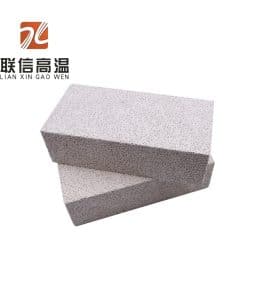The functional characteristics of lightweight insulation bricks include low density, high porosity and low thermal conductivity; they are also used in industrial kilns, building insulation and special industrial applications.

The functional characteristics of lightweight insulation bricks
https://www.lxrefractory.com/product/lightweight-brick-series
Features of lightweight insulation bricks:
Low density: One of the distinctive features of lightweight insulation bricks is their low volume density, generally less than 1.5g/cm³. This low-density characteristic makes lightweight insulation bricks very effective in reducing the weight of a structure, thereby reducing the burden on the overall building or equipment.
High porosity: Another characteristic of this type of brick is high porosity, usually between 40% and 85%. High porosity means more air is trapped inside the material, which provides additional resistance to heat flow, increasing the material’s ability to insulate.
Low thermal conductivity: The thermal conductivity of lightweight insulation bricks is usually less than 1.0W/m·K, which makes them excellent thermal insulation materials that can effectively reduce heat energy transmission and help maintain temperature stability inside equipment or buildings.
High temperature resistance: Although lightweight insulation bricks do not directly contact flames or high-temperature molten materials, they can still operate in high-temperature environments, providing effective thermal insulation protection and are suitable for environments up to 1800°C.
Thermal shock resistance: Lightweight insulation bricks have good thermal shock resistance, which means that in an environment with temperature fluctuations, the material is not easily cracked due to thermal expansion and contraction, ensuring a long service life and reliability.
Uses of lightweight insulation bricks:
Industrial kilns: Lightweight insulation bricks are widely used in various industrial kilns, such as kiln linings and insulation layers in metallurgy, ceramics, chemical and other industries. Not only do they protect the lining structure from high temperatures, they also help save significant amounts of energy and reduce heat loss.
Building Insulation: In the construction industry, lightweight insulating bricks are used to insulate walls, floors and roofs, improving the energy efficiency of buildings and reducing heating and air conditioning costs. Their lightweight nature also reduces the weight burden on the building structure.
Special industrial applications: For environments that require resistance to alkaline erosion, such as magnesia insulation bricks and magnesia-chromium insulation bricks and other special materials, lightweight insulation bricks can also provide good thermal insulation protection and are suitable for use in the steel and petroleum industries. High temperature furnace, catalytic cracking furnace, etc.
High-temperature equipment: In some special high-temperature equipment, such as heating furnaces in the electronics industry or furnaces in the glass industry, lightweight insulation bricks have become an ideal choice for building the insulation layer of these equipment due to their excellent thermal insulation properties and high temperature resistance. .
Energy-saving renovation: When carrying out energy-saving renovation projects, lightweight insulation bricks are widely used to update the insulation layer of old equipment due to their easy cutting and installation characteristics, improving the energy efficiency and operating efficiency of the overall system.
